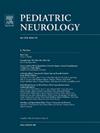Pallidonigral Degeneration: A Recognizable Pattern of Secondary Degeneration Following Striatal Injury
IF 3.2
3区 医学
Q2 CLINICAL NEUROLOGY
引用次数: 0
Abstract
Primary brain injuries can give rise to specific, predictable patterns of secondary neuroaxonal degeneration. We report a novel imaging pattern of pallidonigral degeneration involving both the globus pallidus and the substantia nigra following ipsilateral striatal insult in children. In this clinical report, we present a series of 10 pediatric patients with secondary pallidonigral degeneration in three distinct temporospatial patterns. Pallidonigral degeneration manifested with cytotoxic injury in the globus pallidus around day 6-7 after symptomatic presentation of acute striatal injury, followed by additional involvement of the substantia nigra around day 9-10, with documented resolution in one patient by approximately one month. In patients with subacute or chronic progressive striatal injury, pallidonigral degeneration may be acute at the time of initial magnetic resonance evaluation. Recognition of these imaging patterns allows their distinction from ongoing damage linked to the underlying etiology of striatal insult and is crucial for directing appropriate management.
苍白质退化:纹状体损伤后继发性变性的可识别模式
原发性脑损伤可引起特定的、可预测的继发性神经轴突变性。我们报告了一种新的成像模式,包括苍白球和黑质在同侧纹状体损伤后的儿童苍白球和黑质退化。在这个临床报告中,我们提出了一系列的10名儿童患者继发的三种不同的时空模式。在急性纹状体损伤的症状出现后6-7天左右,苍白球变性表现为细胞毒性损伤,随后在9-10天左右,黑质进一步受累,有记录的一位患者在大约一个月后消退。在亚急性或慢性进行性纹状体损伤的患者中,在最初的磁共振评估时,pallidonial退变可能是急性的。识别这些成像模式可以将其与纹状体损伤的潜在病因相关的持续损伤区分开来,对于指导适当的治疗至关重要。
本文章由计算机程序翻译,如有差异,请以英文原文为准。
求助全文
约1分钟内获得全文
求助全文
来源期刊

Pediatric neurology
医学-临床神经学
CiteScore
4.80
自引率
2.60%
发文量
176
审稿时长
78 days
期刊介绍:
Pediatric Neurology publishes timely peer-reviewed clinical and research articles covering all aspects of the developing nervous system.
Pediatric Neurology features up-to-the-minute publication of the latest advances in the diagnosis, management, and treatment of pediatric neurologic disorders. The journal''s editor, E. Steve Roach, in conjunction with the team of Associate Editors, heads an internationally recognized editorial board, ensuring the most authoritative and extensive coverage of the field. Among the topics covered are: epilepsy, mitochondrial diseases, congenital malformations, chromosomopathies, peripheral neuropathies, perinatal and childhood stroke, cerebral palsy, as well as other diseases affecting the developing nervous system.
 求助内容:
求助内容: 应助结果提醒方式:
应助结果提醒方式:


